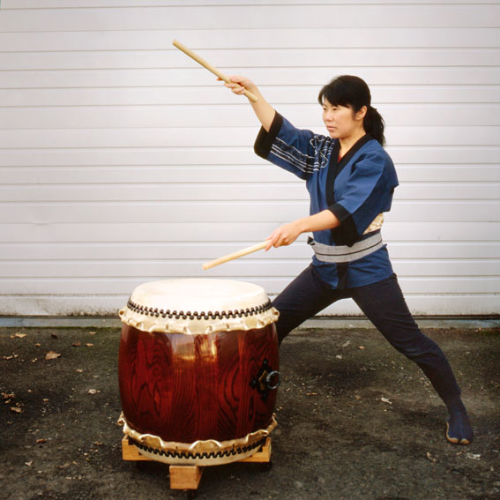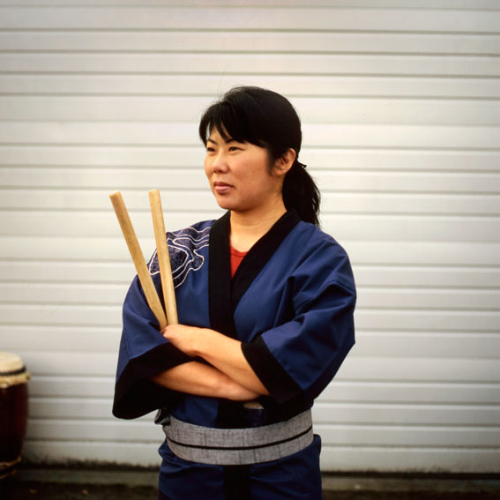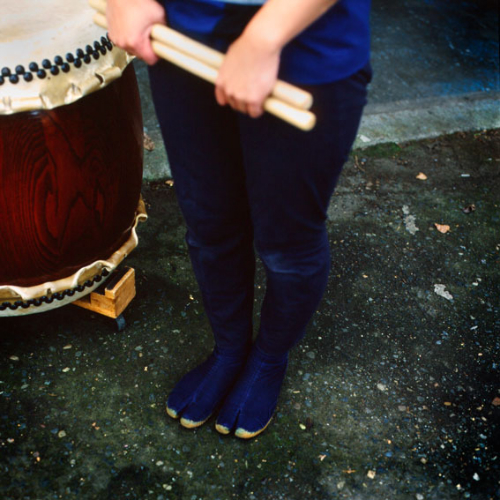Michelle Fujii is the artistic director of Portland Taiko, as well as a talented performer. She sat down, and played with Audra Marie DeWitt, for a Tom Tom Mag interview. She talks about her heritage, Taiko history (which will take you by surprise), and the presence of the art form on the West Coast today.
AudraMarieDeWitt: So, what is taiko? Can you give me an introduction to the art form?
MichelleFujii: Yes! Taiko translates directly into drums, so the word taiko is a fairly generic term. Modern taiko has a long history, with roots in Japanese folk and classical traditions, but the idea of Kumi-daiko, or ensemble drumming, is quite recent – it came about in the 1950’s in Japan. In the United States taiko is even more recent, it got its start in the late 60’s. Seiichi Tanaka, who immigrated in 1967 and founded San Francisco Taiko Dojo, is usually credited as being a taiko pioneer. Groups in Los Angeles and in San Jose formed in the same time period, and San Jose Taiko is actually where I started playing.
AD: Taiko is recent! I didn’t know that.
MF: I love to reflect on culture and ethnicity, and examine music in the context of also looking at culture. What most people don’t know about taiko is how it came of age parallel to the civil rights movement. The late sixties and seventies was a time of huge change for Asian Americans in the United States – there was incredible expression with regards to ethnicity and identity. Kumi-daiko really spoke to Asian Americans and since the art form was new, it allowed for different interpretations and freedoms. Many third generation Japanese Americans readily identified with it, especially at the time when they were struggling with things like fighting for reparations for the internment camps their parents for forced into during WWII. People wanted to be loud and taiko was part of their voice.
AD: Can you talk about gender and playing taiko? What is your experience and have women been involved in taiko since the beginning?
MF: Absolutely, women have been involved in kumi-daiko in North America from the get-go. In fact, women have always been a majority of taiko players. However as far as professional players are concerned, there are more men, which is reflective of the glass ceilings you find in other professions, I think.
AD: There is a rich tradition associated with taiko. How do you teach someone to play? Are there traditional methods of teaching? How do you pass the history of the art form?
MJ: You empower your body in order to play – taiko is a really physical art form. This empowerment is part of the foundation of our performance. There’s a reason we stand the way we do! In taiko, we observe an oral tradition and that’s generally how we teach everything from learning new rhythms to history of the art form. Of course, we are versatile and taiko is always evolving – so we’ve done collaborations with composers requiring written western transcriptions. It’s all been incredible fun.
AD: You are a professional taiko performer. What does taiko mean to you, on a really personal level?
MJ: My grandparents were all forced to relocate in internment camps during WWII. So for me, the experience of taiko, with an emphasis on speaking up and telling stories in order to respect and honor the past, is personal. I want the personal experiences of immigration, internment, and struggle to be heard. That’s part of why performing taiko is so meaningful to me.





Why is her costume on backwards?